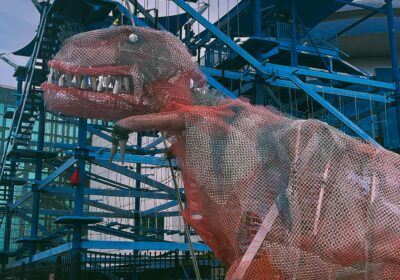CAM’s exhibition explores Cuba and U.SA.’s relationship

CAM opened its new exhibition about Cuba on Friday. SPECIAL TO THE ORACLE/ CHAVELLI GUZMAN
The Contemporary Art Museum (CAM) unveiled its new exhibition Friday, but it’s name may be a bit misleading at first.
The exhibition, “Climate Change: Cuba/USA,” was purposefully named according to CAM’s handout. However, it has nothing to do with global warming.
Rather, this exhibition features art that comments on the constantly changing relationship between Cuba and the U.S.
In an email to The Oracle, Noel Smith, the deputy director of CAM and the curator for this exhibition, said the controversy that now surrounds the term “climate change” is very similar to that of the relationship between the two countries.
“I wanted to look at what is happening with Cuban and Cuban-American artists regarding the dynamics that are happening between Cuba and the United States; these constant fluctuations on both sides that may or may not be leading to any kind of real change,” Smith said. “How are they affecting their lives and their artistic practices?
“The artists come from different generations, their experiences living in and out of Cuba are varied, as are their aesthetic expressions. Climate change is a slow process, and the term is charged. We just turned it around a bit to mean the gradual changes that are affecting this important relationship between our two countries, which is quite equally charged.”
The exhibition features the Cuban and Cuban-American Artists, Celia y Yunior, Antonio Eligio Fernández “Tonel,” Javier Castro and Glexis Novoa.
As students enter the exhibition, they are greeted with a very strong scent of tobacco which can’t be pinpointed just yet.
Then, as they move along, they come across four video installations of varying sizes. One of these videos may make the faint-hearted squirm a bit as it only shows two worn-looking hands touching what looks like raw chicken meat, accompanied by sound.
“Castro presents four richly chromatic and visually mesmerizing interrelated digital videos, collectively titled “Cuatro Cosas Básicas/Four Basic Things,” that reflect on basic aspects of human behavior, desires and struggles,” Smith said. “The approximately six-minute videos, filmed in Castro’s marginal Old Havana neighborhood and in Miami, are arranged in the gallery for simultaneous viewing.
“Through single metaphorical images and repetitive actions, the works speak compellingly of life in Cuba while addressing issues of concern shared by individuals in contemporary societies.”
Moving along, the tobacco smell is finally discovered to be coming from a large upside down V-shaped hut using tobacco leaves as a makeshift roof.
“Their (Celia y Yunior) structure “Varaentierra,” built on site at CAM, takes its inspiration from a rustic storm shelter common in rural Cuba, and incorporates tobacco leaves and stripped tobacco stalks as well as historical research in the form of text,” Smith said. “The work investigates the history of unionism that united Tampa and Havana cigar workers in the late 19th and early 20th centuries.
“What was in Tampa once a thriving, important industry that supported many thousands of families, has declined into a tourist-oriented, boutique attraction, mirroring a similar process experienced by the cigar industry in Cuba.”
Next to this structure, students can see marble slabs with graphite drawings on them. One of these sticks out as it shows the word “Trump” with Nazi imagery and the Confederate flag.
“Glexis Novoa’s installation examines the development of his work from his native Cuba to his life in the United States, and, finally, to the recent re-establishment of his studio in Havana,” Smith said. “Included are exquisite graphite drawings on reclaimed marble slabs that speak to the political power of architecture, colorful paintings that reflect on the new Cuban ‘wordscape’ he encountered, and vintage flags and ephemera which focus on aspects of Cuban Revolution ideology.”
Behind these installations, students can see various flags above their heads, as well as posters on the wall, reminiscent of a revolutionary Cuba.
As the Cuban and U.S. relationship continues to fluctuates, the relevancy of this exhibition is evident.
“Closing our borders and our minds are not viable alternatives in this globalized world,” Smith said. “We need to learn about and welcome other cultures and societies, and a university museum can provide vehicles for this type of cultural awareness and ultimate acceptance of how difference can improve and expand our lives. More particularly, Cuba is a close neighbor and we have a long shared history, and the more we understand each other the better our situation will be.”







